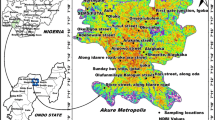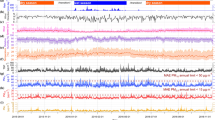Abstract
Air pollution has become a subject of great interest on the global scale from both the regulatory and the scientific points of view. This is a result of the expanding economies, increasing population and urbanization. Particulate matter pollution has become a serious concern in urban areas due to its adverse impacts on human health (US EPA 2009). Most of the previous studies reported in the literature on particulate air pollution deal with its temporal and spatial distributions as part of routine air quality monitoring (Hitchins et al. 2000; Wu et al. 2002; Levy et al. 2003; Morawska et al. 1999; Zhu et al. 2002), but little work has been done on its vertical distribution in the vicinity of buildings. The horizontal distribution of particles is of interest because it helps town planners to decide on the location of buildings and amenities considering the degree of exposure of occupants to fine and ultra fine particles. In addition to those studies, the vertical distribution of particles also merits consideration because it provides an understanding how particles are distributed with respect to the height of a building so that one can decide on the location of the natural air intake of the building, or the building orientation based on the source of particulate matter pollution.
Access this chapter
Tax calculation will be finalised at checkout
Purchases are for personal use only
Similar content being viewed by others
References
Balasubramanian R, Qian W-B (2003) Comprehensive characterization of PM2.5 aerosols in Singapore. J Geophys Res 108(D16): 4523. doi:10.1029/2002JD002517
Beckett KP, Freer-Smith P, Taylor G (2000) Effective tree species for local air quality management. J Arboric 26:12–19
Cabada JC, Pandis SN (2002) Sources of atmospheric carbonaceous particulate matter in Pittsburgh, Pennsylvania. JAMA 52:732–741
Calvert JB (2004) Wind: an exploration of the wind http://mysite.du.edu/etuttle/weather/wind.htm
Caselles J, Colliga C, Zornoza P (2002) Evaluation of trace element pollution from vehicle emissions in petunia plants. Water Air Soil Pollut 136:1–9
Chan AT (2002) Indoor-outdoor relationships of PM and nitrogen oxides under different outdoor meteorological conditions. Atmos Environ 36:1543–1551
Chan LY, Kwok WS (2000) Vertical dispersion of suspended particulates in urban area of Hong Kong. Atmos Environ 34:4403–4412
Chapman RS, Watkinson WP, Dreher KL, Costa DL (1997) Ambient particulate matter and respiratory and cardiovascular illness in adults: particle-borne transition metals and the heart-lung axis. Environ Toxicol Pharmacol 4:331–338
Charron A, Harrison RM (2003) Primary particle formation from vehicle emissions during exhaust dilution in the roadside atmosphere. Atmos Environ 37:4109–4119
Cuhadaroglu B, Demirci E (1997) Influence of some meteorological factors on air pollution in Trabzon city. Energy Build 25:179–184
Department of Statistics, Singapore, http://www.singstat.gov.sg
Dockery DW, Pope CA III, Xu X, Spengler JD, Ware JH, Fay ME et al (1993) An association between air pollution and mortality in six U.S. cities. N Engl J Med 329(24):1753–1759
Eldred RA, Cahill TA, Pitchford M, Malm WC (1988) IMPROVE—a new remote area particulate monitoring system for visibility studies. In: Proceedings of the 81st Annual Meeting of APCA, Dallas, TX
Frampton MW, Ghio AJ, Samet JM, Carson JL, Carter JD, Devlin RB (1999) Effects of aqueous extracts of PM10 filters from Utah Valley on human airway epithelial cells. Am J Physiol 277:960–967
Fung JCH, Yim SHL, Karl A (2009) Air ventilation assessment of the oil street planning area by CFD approach
Giugliano M, Lonati G, Butelli P, Romele L, Tardivo R, Grosso M (2005) Fine particulate matter (PM2.5–PM1) at urban sites with different traffic exposure. Atmos Environ 39:2421–2431
Gupta A, Cheong KWD (2007) Physical characterization of particulate matter and ambient meteorological parameters at different indoor-outdoor locations in Singapore. Build Environ 42:237–245
Gupta A, Cheong KWE, Wong NH (2003) Characterization of particulate matter in the tropics. Int Conf Healthy Build 2:140–146
Hien PD, Bac VT, Tham HC, Nhan DD, Vinh LD (2002) Influence of meteorological conditions on PM2.5 and PM2.5–10 concentrations during the monsoon season in Hanoi, Vietnam. Atmos Environ 36:3473–3484
Hitchins J, Morawska L, Wolff R, Gilbert D (2000) Concentrations of submicrometer particles from vehicle emissions near a major road. Atmos Environ 34:51–59
Hitchins J, Morawska L, Jamriska M (2001) Dispersion of particles from vehicle emissions around high- and low-rise building. Indoor Air 12:64–71
Ho KF, Lee SC, Chan CK, Yu JC, Chow JC, Yao XH (2003) Characterization of chemical species in PM2.5 and PM10 aerosols in Hong Kong. Atmos Environ 3:31–39
IARC (1989) Diesel and gasoline engine exhausts. Summaries and evaluation, vol 46. International Agency for Research on Cancer, Lyons, France, p 41
IARC (2002) Monography on the evaluation of carcinogenic risk to humans. International Agency for Research on Cancer, Lyons, France
IDEM (2009) Breathing zone. Indiana Department of Environmental Management. www.in.gov/idem
Impens RA, Delcarte E (1979) Survey of urban trees in Brussels, Belgium. J Arboric 5:169–176
International Study of Asthma and Allergies in Childhood (ISSAC) (1998) http://isaac.auckland.ac.nz/
Kakimoto H, Matsumoto Y, Sakai S, Kanoh F, Arashidani K, Tang N (2002) Comparison of atmospheric polycyclic aromatic hydrocarbons and nitropolycyclic aromatic hydrocarbons in an industrialized city (Kitakyushu) and two commercial cities (Sapporo and Tokyo). J Health Sci 48:370–375
Karthikeyan S, Balasubramanian R, See SW (2006) Optimization and validation of a low temperature microwave-assisted extraction method for analysis of polycyclic aromatic hydrocarbons in airborne particulate matter. Talanta, pp 79–86
Kittelson DB, Johnson J, Watts W, Wei Q, Drayton M, Paulsen D, Bukowiecki N (2000) Diesel aerosol sampling in the atmosphere, SAE Paper No. 2000-01-2122
Latini G, Grifoni RC, Passerini G (2002) Influence of meteorological parameters on urban and suburban air pollution. Air Pollution X, Trans Ecol Environ 53
Le Tertre A, Medina S, Samoli E, Forsberg B, Michelozzi P, Boumghar A, Vonk JM, Bellini A, Atkinson R, Ayres JG, Sunyer J, Katsouyanni K (2002) Short-term effects of particulate air pollution on cardiovascular diseases in eight European cities. J Epidemiol Community Health 56(10):773–779
Levy JI, Bennett DH, Melly SJ, Spengler JD (2003) Influence of traffic patterns on particulate matter and polycyclic aromatic hydrocarbon concentrations in Roxbury, Massachusetts. J Expo Anal Environ Epidemiol 13(5):364–371
Li CK, Kamens RM (1993) The use of polycyclic aromatic hydrocarbons as source signatures in receptor modelling. Atmos Environ 27:523–532
Li C, Fu J, Sheng G, Bi X, Hao Y, Wang X, Mai B (2005) Vertical distribution of PAHs in the indoor and outdoor PM2.5 in Guangzhou, China. Build Environ 40:329–341
Manno E, Varrica D, Dongarrà G (2006) Metal distribution in road dust samples collected in an urban area close to a petrochemical plant at Gela, Sicily. Atmos Environ 40:5929–5941
Millero FJ, Sohn ML (1992) Chemical oceanography. CRC Press, Boca Raton, FL, p 531
Morawska L, Bofinger ND, Kocis L, Nwankwoala A (1998) Submicron and supermicron particles from diesel vehicle emissions. Environ Sci Technol 32:2033–2042
Morawska L, Thomas S, Gillbert D, Greenaway C, Rijnders E (1999) A study of the horizontal and vertical profile of sub micrometer particles in relation to a busy road. Atmos Environ 33:1261–1274
NAAQS (2009) National Ambient Air Quality Standard. US EPA, www.epa.gov/air/criteria.html
NEA (2005) Annual Report, National Environmental Agency of Singapore. http://www.nea.gov.sg/cms/pcd/EPDAnnualReport2005.pdf
Ng E, Tam I, Ng A, Givoni B, Katzschner L, Kwok K, Murakami S, Wong NH, Wong KS, Cheng V, Davis A, Tsou JY, Chow B (2004) Final report: feasibility study for establishment of air ventilation assessment system, Technical Report for Planning Department, HKSAR
Nisbet C, LaGoy P (1992) Toxic equivalency factors (TEFs) for polycyclic aromatic hydrocarbons (PAHs). Regul Toxicol Pharmacol 16:290–300
Oberdörster G, Utell MJ (2002) Ultrafine particles in the urban air: to the respiratory tract—and beyond? Environmental Health Perspect 110(8):A440–A441
Palmgren F, Wahlin P, Kildeso J, Afshari A, Fogh LC (2003) Characterization of particle emissions from the driving car fleet and the contribution to ambient and indoor particle concentrations. Phys Chem Earth 28:327–334
Pandey JS, Kumar R, Devotta S (2005) Health risks of NO2, SPM and SO2 in Delhi (India). Atmos Environ 39:6868–6874
Pope CA III, Burnett RT, Thun MJ, Calle EE, Krewski D, Ito K, Thurston GD (2002) Lung cancer, cardiopulmonary mortality and long-term exposure to fine particulate air pollution. J Am Med Assoc 287:1132–1141
Quackenboss JJ, Spengler JD, Kanarek MS, Letz R, Duffy CP (1986) Personal exposure to nitrogen dioxide: relationship to indoor/outdoor air quality and activity patterns. Environ Sci Technol 20:775–783
Ristovski Z, Morawska L, Hitchins J (1998) Submicrometer and supermicrometer particulate emission from spark ignition vehicles. Environ Sci Technol 32:3845–3852
Rogak SN, Green SI, Robin C (1994) A study of vehicle emissions in a traffic tunnel in Vancouver, B.C. Presented in the Annual Meeting of the Pacific Northeast Chapter of the Air and Waste Management Association, Eugene Oregon, Winchester
Rubino FM, Floridia L, Tavazzani M, Fustinoni S, Giampiccolo R, Colombi A (1998) Height profile of some air quality markers in the urban atmosphere surrounding a 100 m tower building. Atmos Environ 32:3569–3580
Schwartz J (1994) What are people dying of on high air pollution days. Environ Res 64:26–35
Shi JP, Evans DE, Khan AA, Harrison RM (2001) Sources and concentration of nanoparticles (10 nm diameter) in the urban atmosphere. Atmos Environ 35:1193–1202
Tai CC, Chong KC (1998) Development of Singapore’s Rapid Transit System and the Environment. Railways and the Environment (Part 2), http://www.jrtr.net/jrtr18/pdf/f26_singapore.pdf
Talebi SM, Adedi M (2005) Determination of atmospheric concentrations of inorganic anions by ion chromatography following ultrasonic extraction. J Chromatogr A 1094:118–121
US EPA (2009) Particulate matter: health and environment. US Environmental Protection Agency. http://www.epa.gov/oar/particlepollution/health.html
Venkataraman C, Lyons JM, Fiedlander S (1994) Size distribution of aromatic hydrocarbons and elemental carbon, sampling measurement methods and source characterization. Environ Sci Technol 28:535–562
Wehner B, Birmili W, Gnauk T, Wiedensohler A (2002) Particle number size distribution in a street canyon and their transformation into the urban-air background: measurements and a simple model study. Atmos Environ 36:2215–2223
Weingartner E, Keller C, Stahel WA, Burtscher H, Baltensperger U (1997) Aerosol emission in a road tunnel. Atmos Environ 31:451–462
WHO (1987) Air quality guidelines for Europe. WHO Regional Publications, European Series No. 23, Regional Office for Europe, Copenhagen
Wu Y, Hao J, Fu L, Wang Z, Tang G (2002) Vertical and horizontal profiles of airborne particulate matter near major roads in Macao, China. Atmos Environ 36:4907–4918
Yu J (2002) Chemical characterization of water soluble organic compounds in particulate matters in Hong Kong. A final report submitted for the provision of service to the Environmental Protection Department, HKSAR. http://www.epd.gov.hk/epd/english/environmentinhk/air/studyrpts/files/wsoc_final_report_v3.pdf
Zappoli S, Andracchio A, Fuzzi S, Facchini MC, Gelencsér A, Kiss G, Krivácsy Z, Molnár A, Mészáros E, Hansson H-C, Rosman K, Zebühr Y (1999) Inorganic, organic and macromolecular components of fine aerosol in different areas of Europe in relation to their water solubility. Atmos Environ 33:2733–2743
Zhu Y, Hinds WC, Kim S, Sioutas C (2002) Concentration and size distribution of ultra fine particles near a major highway. JAMA 52:1032–1042
Author information
Authors and Affiliations
Corresponding author
Editor information
Editors and Affiliations
Rights and permissions
Copyright information
© 2010 Springer-Verlag Berlin Heidelberg
About this chapter
Cite this chapter
Kalaiarasan, M., Balasubramanian, R., Cheong, K.W.D., Tham, K.W. (2010). Vertical Distribution of Airborne Particulate Matter in a Tropical Urban Environment: Changes in Physical and Chemical Characteristics. In: Zereini, F., Wiseman, C. (eds) Urban Airborne Particulate Matter. Environmental Science and Engineering(). Springer, Berlin, Heidelberg. https://doi.org/10.1007/978-3-642-12278-1_15
Download citation
DOI: https://doi.org/10.1007/978-3-642-12278-1_15
Published:
Publisher Name: Springer, Berlin, Heidelberg
Print ISBN: 978-3-642-12277-4
Online ISBN: 978-3-642-12278-1
eBook Packages: Earth and Environmental ScienceEarth and Environmental Science (R0)




